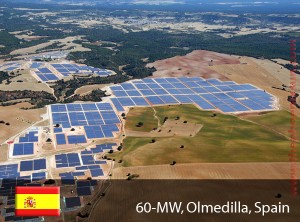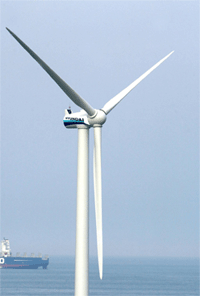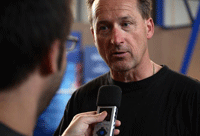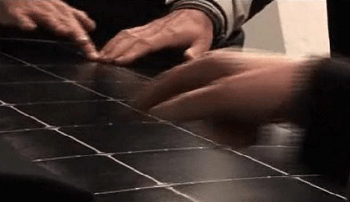Dust: it’s enemy number one for solar photovoltaic panels (PV) in the sunny, warm areas with the most potential for solar power. That’s because it takes less than a tablespoon of dust per square meter to reduce the electrical output of a typical PV panel by 40 percent.
“In Arizona,” says Professor Malay Mazumder of Boston University, “dust is deposited each month at about four times that amount. Deposition rates are even higher in the Middle East, Australia and India.”
Few home owners in the Southwest want to climb up on their roof several times a month to hose off the light-blocking dust. Utility-sized PV installations are hand-washed or use mechanical sprayers — but either way is costly. In the desert there’s the additional problem of increasing water use in an arid land — one that is likely to grow drier as the climate changes.
The solution to this problem (or at least a solution) comes from the U.S. space program — which is fitting, given that PV panels were pioneered by NASA in the 1960s and ’70s to power satellites and, most recently, rovers on Mars.
At the 240th National Meeting of the American Chemical Society (ACS) last weekend, Dr. Mazumder reported on advances in bringing the same technology used to clean dust from the Mars rovers down to Earth.
 The trick to cleaning PV panels without water is to incorporate an Electrodynamic Screen (EDS) like the one on the Mars rovers. An EDS is a thin, electrically sensitive layer on the surface of the panel. When enough dust accumulates on the EDS, a sensor triggers a small electric pulse which repels the dust.
The trick to cleaning PV panels without water is to incorporate an Electrodynamic Screen (EDS) like the one on the Mars rovers. An EDS is a thin, electrically sensitive layer on the surface of the panel. When enough dust accumulates on the EDS, a sensor triggers a small electric pulse which repels the dust.
NASA first developed the idea for an “electric curtain” in 1967. In 2003, NASA’s Electrostatics and Surface Physics Laboratory (ESPL) worked with researchers at the University of Arkansas at Little Rock (where Dr. Mazumder then taught) to design and build an EDS for the Mars rovers. (The ESPL website has a short video showing test modules working under space conditions.)
Mazumder reports that the EDS developed by his lab can remove 90 percent of dust particles from a square meter of PV paneling in two minutes using just 10 watts.
Mazunder said the Earth-version of the EDS should be commercially available within a year.
Not all PV panels may require EDS technology, says Alan Bernheimer, a spokesman for First Solar, the world’s largest manufacturer of thin-film PV.
“Theoretically it would be possible to apply this technology to thin film solar modules,” Bernheimer wrote in an Email. “First Solar’s advanced thin film technology, however, is productive in diffuse and lower light conditions, such as those caused by dust.”
While even thin-film panels eventually need to be cleaned, Bernheimer said First Solar has no plans to adopt the EDS technology.
For traditional silicon-based PV manufacturers, however, the development of waterless cleaning technologies is likely to be seen as a milestone on the road to renewable, sustainable, energy.
You can read a 2008 paper about EDS technology co-written by Prof. Mazumder here (PDF).






